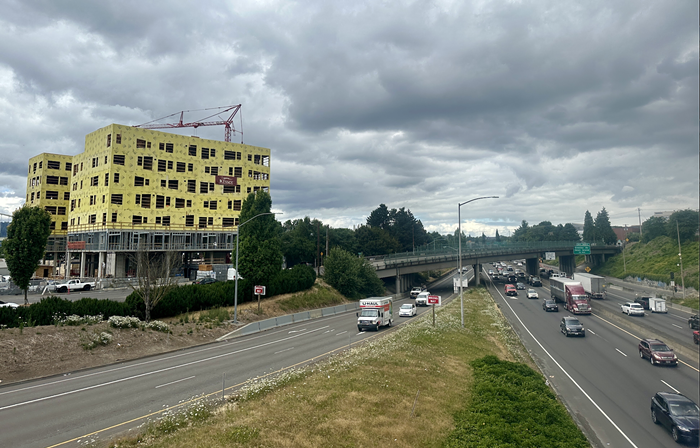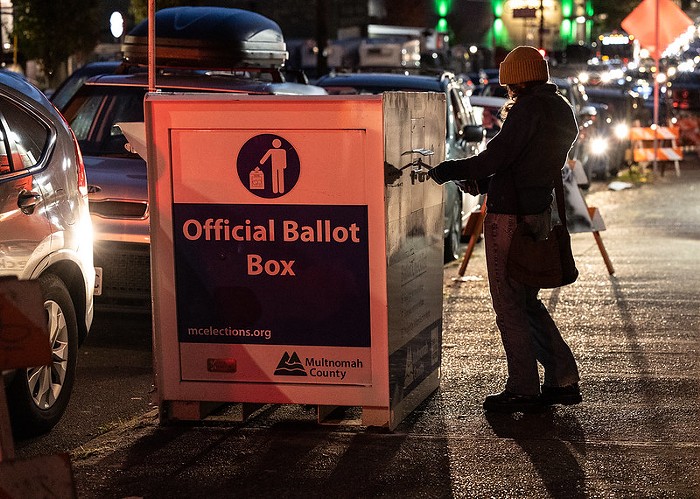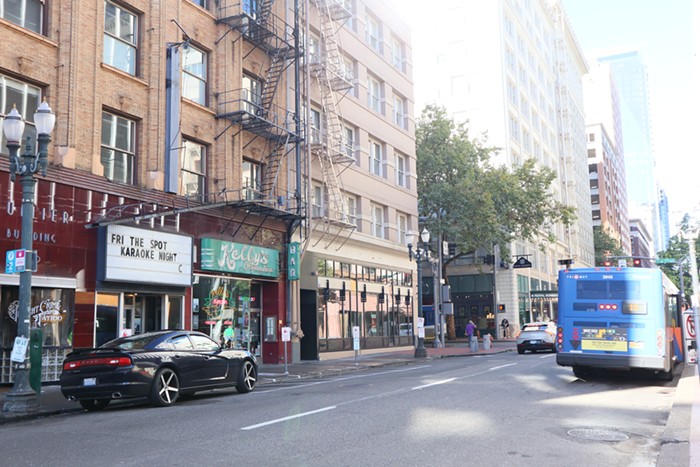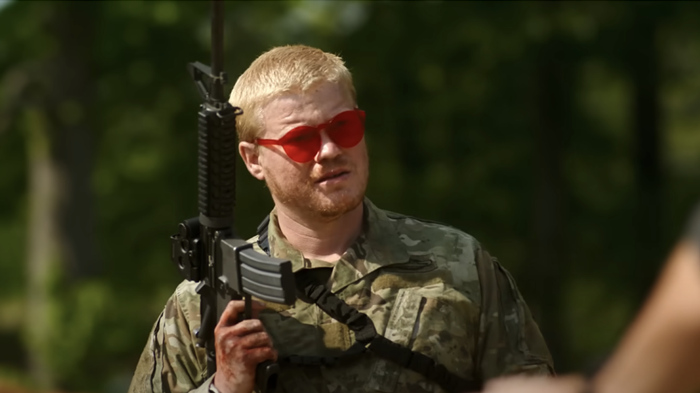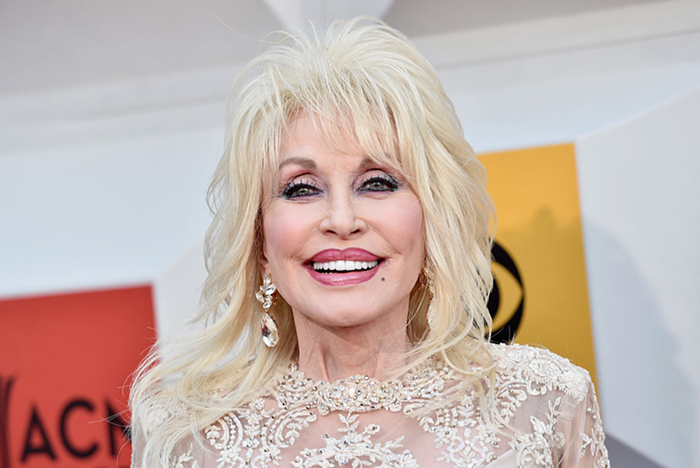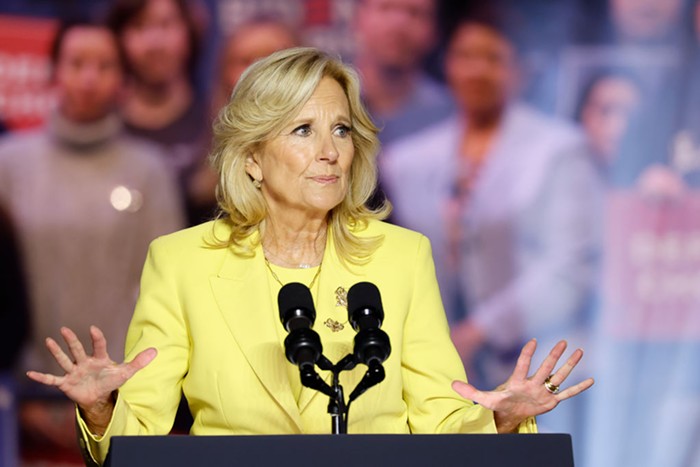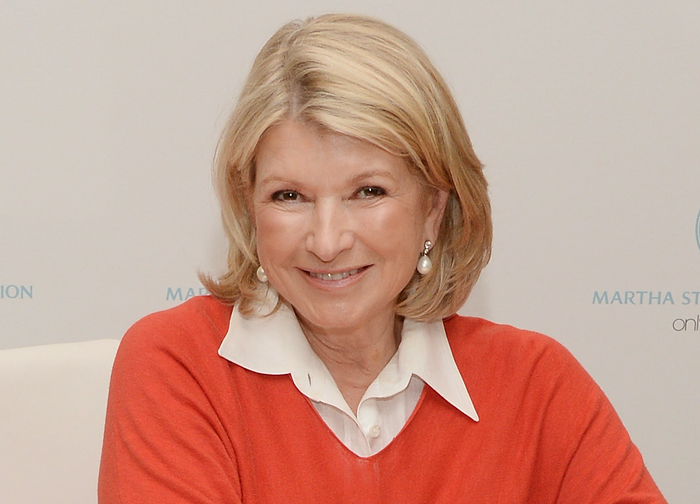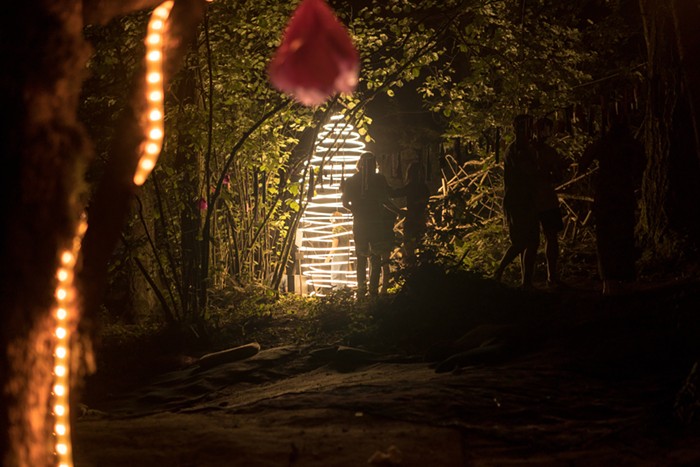
Mayor Bud Clark
by Amy J. Ruiz
"To tell you the truth, I didn't pay attention," former mayor Bud Clark says, sitting in a booth at the Goose Hollow Inn and trying to recall why 11 people challenged him for his job in 1988.
He can recall details of his original 1984 campaign, in which he defeated incumbent Frank Ivancie in the primary—like the St. Johns Parade, where Mayor Ivancie was booed, and Clark the stealth candidate was cheered. "I knew I was going to win," he says.
But in 1988, Clark was busy being mayor—doing things like overseeing construction of the Convention Center, and implementing community policing—while also trying to campaign. What he remembers most is that he "really disliked calling people for money," he says. He's not quite sure where the election night party was.
His campaign manager, Julie Williamson, remembers. "The Hilton Hotel," she says, where people watched the returns roll in. "It seemed pretty certain that Bud would win, but we couldn't take it for granted," Williamson says. The setting was apropos: "The second campaign was a much more traditional, serious campaign. He was part of the establishment to a much greater degree," Williamson explains.
In the primary, Clark faced 11 opponents, including the Port of Portland's Lloyd Anderson, and two former police chiefs. "I'd fired them both," notes Clark. Williamson remembers a candidate "who always wore a green mask. I can't remember what the point of it was." Clark says there was pressure on Anderson from the likes of Bill Naito to drop out of the race—but he stayed in, and scored enough votes to keep Clark from winning outright.
Instead, Clark faced former police chief Ron Still in the November general election. He ran a few TV ads, in keeping with the more traditional campaign vibe. And Williamson worked "to get people to take him seriously, and realize what a fantastic job he was doing," she recalls. "Everybody thought he was a kick, but they really weren't paying attention as much to his accomplishments."
The strategy paid off: Clark nabbed nearly 59 percent of the vote and served another four years at city hall.

Tres Shannon
By Wm. Steven Humphrey
[EDITOR'S NOTE: Tres Shannon has been an underground mainstay in Portland since the dawn of time. He started the seminal punk club X-Ray Café, booked Berbati's, and now co-owns two Voodoo Doughnuts locations... but what was he doing in '88?]
"In 1988 I was working at Kinko's—helping bands make posters and stuff. And true story: I am personally responsible for Kinko's dress code. They used to let employees' dress how they liked, until I came to work wearing a weird tie and hat. The big wig came down from Seattle and put a stop to that. But I met so many bands at Kinko's, and it really introduced me to that scene. I was in a band called the Kurtz Project and in '88 we'd play the Commodore or Zorba the Greek, which later turned into the Red Sea, which of course isn't around anymore either.
"Band-wise there were the Hell Cows, Smegma, the Jackals, Napalm Beach... but what really influenced the Portland music scene at the time were the punks from Gresham. Sean Croghan (who would start Crackerbash), Tony Graft, Kevin Bonet, Ric Eraser... they rolled in from Gresham and set the whole scene on its ear. They were crazy drunks, totally nuts, and had a huge influence. But in '88, there weren't nearly as many bands as there are now. Then there were maybe... 30 bands? Now there's like 30,000.
"There was tons of acid back then, tons of LSD, meth was crank at the time, and the kids at Reed were making it—I'm pretty sure the summer of '88 was when everybody spent a lot of time organizing their spice cabinets. There were also a lot of skinhead activity. Shows would get shut down, fans and police would get attacked—Portland was a lot scarier back then.
"23rd Avenue was a really skeevy place—but look at it now. There's this real sense of 'preciousness' in Portland, y'know? I still love it, but take New York for example: Everybody jaywalks, nobody has a bike lane, there are cracks in the sidewalks, and everybody's fine. Here, if something is old or doesn't look perfect they wanna rip it up. It's getting like Scottsdale, Arizona. If Portland's so cool, and everybody wants to move here, why are we trying to change it all the time? We need to get back to taking acid, making art, and doing some serious gettin' down."

THE POWER SUIT
by Marjorie Skinner
Back in '88, Portland wasn't really on fashion's radar. Vivian McInerny, who covered New York Fashion Week for the Oregonian then, as she does now, recalls the difference 20 years has made. "No one knew where—or what—Oregon was. I explained to one PR woman that it was on the West Coast and she said—I swear to god—'I thought California was the West Coast.' Now they say, 'I want to move to Oregon. Can you help me?'"
While the fashion flock may not have paid Portland any mind back then, stylish Portlanders were not as out of it as they might have thought, thanks in large part to the locally owned, fashion forward store Mario's (currently located at 833 SW Broadway, with outposts in Bridgeport Village and Seattle). Mario Bisio, who became a partner in the family business in 1973 alongside his father, was traveling the world to bring the best of high fashion home. His recollection of what was hot in '88? The double-breasted power suit—Armani in particular.
"The movie The Untouchables had just come out," Bisio recalls of the film, which featured generous frames of Armani clothing. "It was also coming after a huge slump in the economy in the '80s, and people were talking about the power of the suit and being taken seriously." In those days, the double-breasted look accounted for about half of all Mario's men's suit sales, compared to today's approximately three percent.
1988 was also a year in which designers pulled a switcheroo on women by suddenly yanking hemlines way up—it didn't go over very well. "You can not dictate inches in skirts from season to season," says Bisio. "Customers are intelligent, and the clothing was expensive then and expensive now; they are not disposable. I remember that as a lesson." He also saw the surge in power suits as translatable to his female client base and their resistance to super short lengths. "Women were becoming more powerful in business and needing to be taken seriously too—they couldn't wear a super short suit."

Dark Horse Publisher Mike Richardson
By Erik Henriksen
"We're Comic Book City, USA," says Mike Richardson, the publisher of Dark Horse Comics, when I ask him about Portland's comics community. True enough: Today, Portland boasts several comic book publishers (there's Dark Horse, sure, but don't forget Top Shelf and Oni), is a hotbed of indie comics activity, and is home to a few of comics' biggest writers and artists. 20 years ago, though? Not so much.
"If you wanted to have a gathering in those days with comics people, we would have a party and a few people would show up and we'd all talk to each other," Richardson remembers. "Now, there's a huge professional comics contingent living here in Portland. It's a different world."
Dark Horse started operating just outside of Portland, in Milwaukie, in 1986. "Milwaukie, at that time, had a lot of empty buildings, and had gone through a tough economic period," says Richardson, who grew up in the suburb. "One of the buildings that was available was the one where I used to buy my comics. So for me that was karma, and I wanted that to be the [Dark Horse] building. Luckily for us, we were able to acquire that building."
"If you wanted to be in comics when I started Dark Horse, you went to New York. There wasn't anything out here," Richardson says. "The fact that we were sort of out of the limelight probably helped us, because it gave us a sort of outlaw, outsider mystique." That didn't last long, since Dark Horse—which had achieved critical success with books like Paul Chadwick's Concrete, but hadn't yet delved into the lucrative world of licensed comics like Buffy the Vampire Slayer and Star Wars—began to import talent to the Northwest.
"From the time we started the company, we started moving people out here. And after years and years of that, several of the companies that have started here are from people who worked at Dark Horse and decided that they could do what I do," Richardson says. "We certainly didn't bring everybody in, but the people we brought in then brought in people who then brought in people."
But what Dark Horse was doing in '88 didn't only affect Milwaukie, or Portland. Thanks to Dark Horse snagging talent like Frank Miller (who would publish Hard Boiled and Give Me Liberty through Dark Horse, as well as a little comic called Sin City) and introducing licensed comics like Alien vs. Predator, the decisions Dark Horse made in the late '80s are still being felt today all over the world in both bookstores and multiplexes.

THE PORTLAND THEATER SCENE
by Alison Hallett
"When they called for a line, they weren't necessarily referring to the script."
That's how actor Vana O'Brien memorialized the now-defunct Storefront Theater at the Drammy awards a few weeks ago. Though it closed in the early '90s, the Storefront still has a reputation for having produced some of the edgiest avant-garde theater in Portland's history.
According to former Storefront marketing director Mark Grimes, the company's first show was an all-nude version of Lysistrata, performed at a city-sponsored, Woodstock-esque music festival called Vortex 1. They took up residence in the North Russell storefront that now houses the White Eagle, then moved to the Paris Theater, West Burnside's porn theater-turned-venue-turned-porn theater, where, Grimes says, "You could do whatever you wanted in the space, so long as you swept the rats up afterward." The material ranged in subject matter and seriousness, from Rap Master Ronnie (a satirical musical about Ronald Reagan written by Garry Trudeau) to August Wilson's Ma Rainey's Black Bottom.
"It was really, really interesting theater," says Grimes. "Some of it worked, some of it didn't, but you didn't care because they were pushing the boundaries. For a short period of time, Storefront owned it."
But it wouldn't last. Several years after moving into the Portland Center for the Performing Arts (PCPA), which opened in 1987, Storefront folded. "We moved into PCPA, and then it became 'art versus commerce,'" says Grimes. "PCPA had a hell of an impact on the scene."
A huge turning point in Portland's theater scene came in 1988, when Portland Center Stage moved into PCPA as a satellite of Ashland's Oregon Shakespeare Festival (OSF). "There was a lot of concern about OSF coming in to Portland," PCS marketing director Cynthia Furhman told me. "Portland had a robust theater scene, but it was mostly fringe theaters, and suddenly we were this machine in town. And several theaters did fold after we moved in."
The opening of a Portland arm of the highly regarded Shakespeare festival was big news: Reporters from Time magazine and the LA Times covered opening night of the inaugural production, George Bernard Shaw's Heartbreak House. "We all got really, really drunk that night," remembers Furhman. "A few people slept under their desks."
Time called the PCS/PCPA union "Portland's cultural calling card," a bid for big-city sophistication—so perhaps it can be seen as an indication of how far the city has come that the company has since severed ties with Ashland and moved into its own space at the Gerding Theater at the Armory.

Ann Huntwork, Our House Social Worker
by Amy J. Ruiz
In December 1988, the Oregonian reported that 465 people in the state had been diagnosed with AIDS—most of them in Portland. Tragically, 270 had already died.
It was the height of the nationwide AIDS crisis, seven years since the Centers for Disease Control and Prevention first identified the disease, but still eight years before life-saving protease inhibitor drugs were available.
In Portland that fall, after the Oregonian ran another story—about a homeless man who died of AIDs complications on the streets—a group of people founded Our House, a five-bed foster care facility. Funded with $1,500 a month in donations and meager Medicaid or social security payments, nurses and social workers provided medical care, grief counseling, and assistance with everyday living.
"It was a pioneering time, I guess you can say," says Ann Huntwork, Our House's first social worker, who worked at the facility for 10 years. In the beginning, a lot of folks "had no clue what to do with people with AIDS," she says. The issue was "not just fear but dislike of people with AIDS. Most of the people at that point were gay."
Though Our House's Northwest Portland neighbors were generally accepting of Our House in 1988, there was one nearby apartment building "where there was a flag hung out the window that was like 'fags go home,' or something like that," Huntwork says.
"There were so many rumors floating around, that if someone used a bathroom, you could catch it off a bathroom seat, or if someone was coughing you could catch it," she says.
Huntwork worked with residents' families to educate them—many family members ended up volunteering at Our House—and she also worked with residents to make their final weeks as comfortable as possible.
The staff would ask patients how they envisioned their death, and would work to make it happen. One man was too ill to make a last visit to California's redwoods, so staff located a few branches and hung them over his bed. "One guy wanted the window open so he could get out in a hurry," Huntwork says. "Some guys were watching soap operas as they were dying. We learned so much about people's preferences and ways of thinking. I feel like I was never the same person after having spent those years there."

Restaurateur Greg Higgins
by Patrick Alan Coleman
Portland, in 1988 B.F. (Before Foodies), was largely a culinary wasteland—a fact acknowledged by the press of the time, which lavished praise on any place that didn't use a can opener to prepare soup. The restaurant scene was dominated by kitschy cult eateries and ancient standbys, but there was a light shining in Portland's frozen industrial food miasma. His name: Greg Higgins.
"Not to belittle it," Higgins begins, pondering Portland food in the '80s, "but it struck me that everyone was cooking out of Gourmet magazine from like 1968 or something. There were obviously excellent ingredients, but... it was very dated."
In 1984, Higgins was drafted by the Heathman Hotel restaurant to be executive sous-chef, but was promoted to head chef after his colleague began suffering from the excesses of the era. At the Heathman, he baked his own breads and cooked in the rural American tradition. He recognized the quality of local ingredients, but the problem was how to bring them to the table.
"Direct relationships [with growers] at that time were hard to find," he explains. "I do a lot of biking. I would travel out in the valley and look around for operations that might be approachable so I could buy my fruits and vegetables."
Eventually Higgins grew a local distribution network, even recruiting the Heathman's groundskeepers to grow herbs or vegetables for his kitchen. In 1988, the 30-year-old Higgins was running B. Moloch/Heathman Bakery and Pub, and was one of the first Portland chefs to cook in the way that has become standard operating procedure for most acclaimed restaurants to open in the past two decades: seasonal, local produce, paired with artisanal breads and house-cured meats.
"I just wanted things to taste like I remember off the farm," he muses, "and you couldn't achieve that by calling up a big produce house."
B. Moloch eventually gave way to Higgins' eponymous eatery on Broadway, where he continues to teach and influence area chefs. But new hot chefs come and go; a local food scene keeps its health through the continuing ingenuity of chefs like Greg Higgins.

Mark Wanaka of Crazy 8s
by Ned Lannamann
[EDITOR'S NOTE: To promote the release of their live album, Big Live Nut Pack, rock-ska band Crazy 8s performed eight shows in Portland on August 8, 1988 (8-8-88), culminating in a big show at Starry Night. Here guitarist Mark Wanaka looks back on that long, memorable day. Looking forward, Crazy 8s will play a reunion show on August 8, 2008 (8-8-08) at the Bite of Oregon festival.]
"We thought 'what better way to release that record than to do it on 8-8-88 and perform EIGHT shows throughout the Portland area?' We spent 8-7-88 securing an entire PA system, drums, amps, etc. to the "stage": a 40-foot flatbed truck trailer. The next day we met around 8 am (when else?) and commenced our first "show" at 10 am. We played a few songs, hawked our record, and promoted our final show that evening at Starry Night. We did this seven times, covering the greater Portland area. We didn't have permits, and were lucky to get away without even a parking ticket.
"The show that evening at Starry Night was epic! Since our album was titled Big Live Nut Pack, everyone at the door got a free bag of peanuts—salted, in the shell. Our keyboard player, Casey Shaar, donned a Mr. Peanut costume and opened the show with Vegas-style renditions of Crazy 8s tunes.
"Now at first it was just a few nuts flying through the air, but the more Casey played, the more peanuts were hurled from the audience. By the end of his set, a veritable blizzard of nuts rained down on him, including a few from myself and the other guys in the band.
"But it didn't end there. When we took the stage, the onslaught continued! Peanuts everywhere. By the end of the night, the peanuts in front of the stage had been 'processed' into a crude, chunky-style peanut butter about an inch thick!
"The band by this point was basically delirious—we'd been up early, playing music all day, pretty much drinking nothing but beer, yet here we were, well after midnight into a three-hour show. Someone vaulted from the balcony to the speaker stack on the left side of the stage and launched himself onto the astonished crowd below—easily a 15 foot drop! The crowd actually caught him, or at least broke his fall enough to prevent serious injury.
"I will say that the music scene back then was stronger than in recent years, though Portland seems to be experiencing an upswing. But at least Portland wasn't the Wuss Rock Capital of the USA like it is now! Yes, we're all impressed you went to college, and are really into literature, and your music is written for those in the know. Emperor's new clothes—boring to listen to, boring to watch. And, for Pete's sake get a sense of humor—you're getting paid to play music!"

Author Tom Spanbauer
by Alison Hallett
"I'm trying to think of what we did in 1988. There were a couple of pizza places..."
Over an iced decaf soy latte at Belmont's Muddy Waters café, local author Tom Spanbauer is having trouble coming up with an appropriately nostalgic take on Portland's past. "Portland felt pretty provincial. I was young, and I was from New York, and I just didn't really get it. I didn't think I could live here."
In 1988, Spanbauer—best known as the author of the rightfully beloved The Man Who Fell in Love with the Moon—was splitting his time between his New York City apartment and the Portland home of his then-lover. He'd just finished his first novel, Faraway Places, about a boy in Idaho in the 1950s. The book recently saw a 20th anniversary reprinting, which led to a spate of readings around town and an invite to speak to the City Club about racism, a major theme in the novel.
When writing the book, he tells me, "I knew I wanted to talk about my father and what it felt like growing up with that father—and my father was deeply racist, so the book became about racism in that way. I didn't really know what I was doing. The innocence of it, it's charming: I probably wouldn't try to tackle something like that now. I'm a little more jaded, which is unfortunate."
Spanbauer moved here full-time in 1990, after two years of cross-country commuting, and he says it was several years before he started to see the city mature.
"It wasn't until the No on Nine campaign [a successful 1992 campaign to defeat an anti-gay ballot measure] that I felt like the city grew up. The way everybody came together to fight the Christian right—it really created that sense of artistic community that had been missing." He gestures around at the coffee shop and at the busy Belmont neighborhood in general. "There were no places like this in 1988. I can't remember any place that served good coffee. Where the Stumptown is now used to be a thrift store... There just weren't many young people around. To have found a place like this is now in 1988? I would have been so happy."

